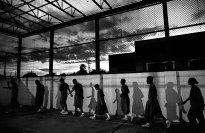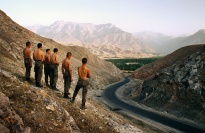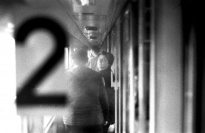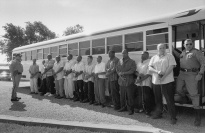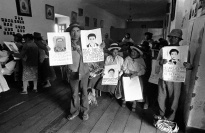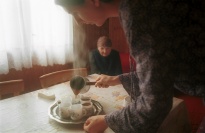About Moving Walls 8
In a culture barraged and desensitized by the fleeting, split-second imagery of modern technology and commerce, a photography exhibition is an exotic experience, both calming and deeply moving. It requires the viewer to pause before a still image, to truly see what it depicts, to reflect and react to its meaning. The best documentary photographs, combining art and journalism, touch people with stories full of insight and emotion.
In the eighth Moving Walls exhibition, five individual photographers and Peru’s Truth and Reconciliation Commission take on the task of storytelling with evocative results. Their subjects cover a wide range, but all provoke questions of great social significance.
The fertile and populous Ferghana Valley is divided among Uzbekistan, Tajikistan, and Kyrgyzstan, countries struggling to establish their post-Soviet identities. Jonas Bendiksen’s images look at some of the issues most crucial to the valley and Central Asia, in particular the resurgence and consequential repression of political and religious Islam.
Helene Caux’s photographs document the daily travel of Serbs, Roma, and Albanians who—in sharp contrast to segregated Kosovar life—ride a train together across Kosovo, visiting friends or returning home. Dubbed the “Freedom of Movement Train,” it reflects the continuing tensions among ethnic groups in that war-ravaged region while offering the promise of a more harmonious time.
Another view of the region’s recovery from war comes from Jeffrey Ladd, whose images personalize this collective struggle, showing a Serbian woman’s journey home and her family’s attempt to reconcile the old way of life with the new.
As open society endures daily challenges in post-war regions around the world, the United States faces its own pressing crises. In New York and Texas, Andrew Lichtenstein examines the immense social, political, and economic repercussions of America’s prison complex through the stories of those who know it firsthand.
Steve Liss also critiques the punitive approach of the U.S. prison system, turning his lens on an under-resourced, overcrowded juvenile detention center near Laredo, Texas. With his photographs, Liss challenges viewers to see these kids not as a social ill but as a social responsibility.
In an effort to remember the past, Peru’s Truth and Reconciliation Commission has compiled a visual narrative of the two decades of violence that caused the deaths or forced disappearance of nearly 60,000 Peruvians. Selected from an archive of over 20,000 photographs taken between 1980 and 2000, these images help reconstruct the history of one country’s brutal conflict.
